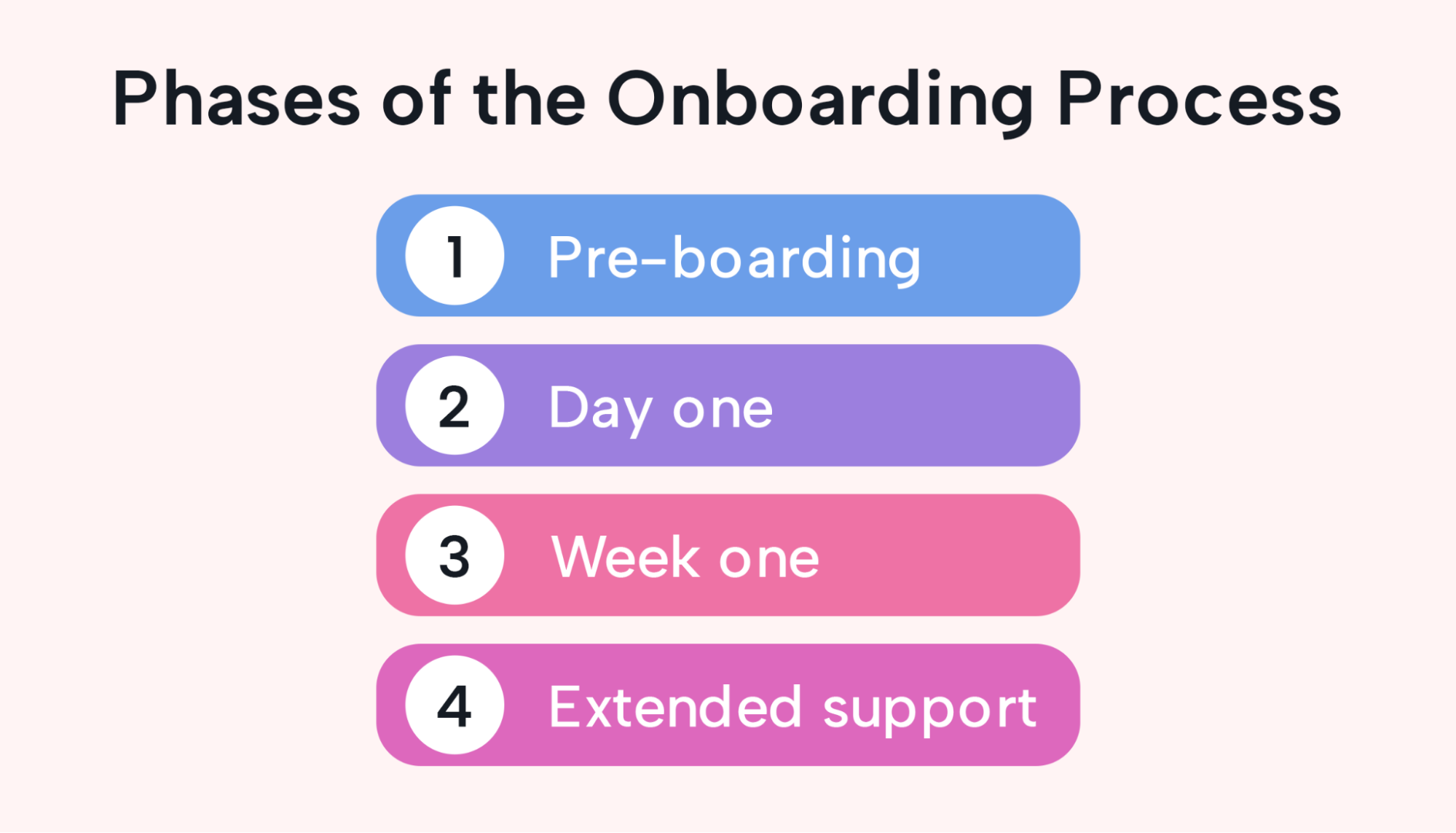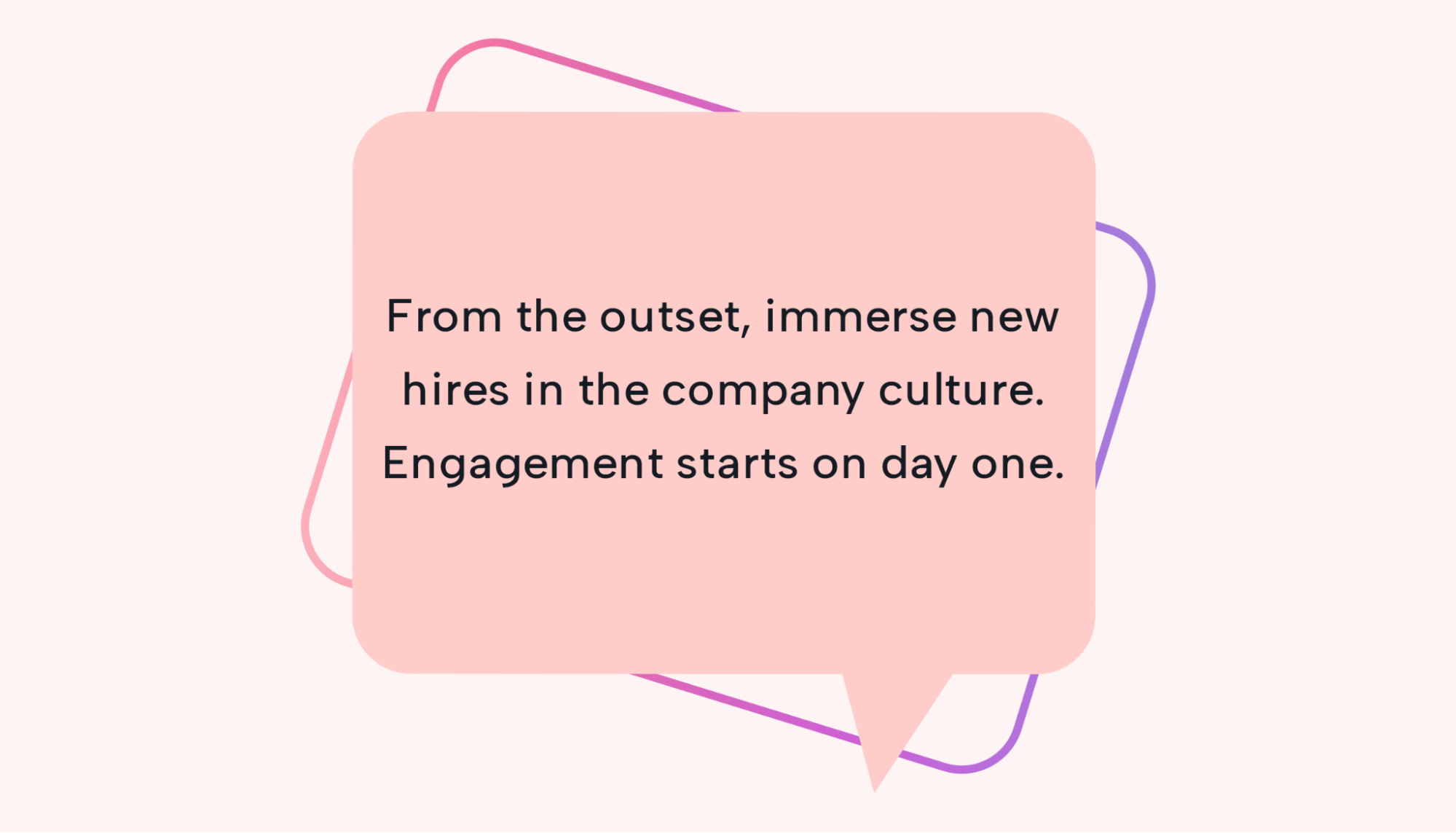There’s nothing worse than high turnover. It’s costly, disruptive, and, unfortunately, all too common.
An effective onboarding process can help reduce turnover by setting the stage for a successful, fulfilling, and productive employee-employer relationship.
Onboarding is the way in which a company brings on new hires. And it’s important to get it right to help your new employees feel good about their new roles.
Read on to learn everything you should know about the employee onboarding process so you can integrate new hires effectively from the start.
What is employee onboarding?
Employee onboarding is a thoughtful strategy used to guide every new employee as they arrive at an organization. It ensures they align with company objectives and introduces them to the organizational culture.
The goal of onboarding is to provide essential resources and access from day one to enable productivity and compatibility.
More than just showing someone their new job, onboarding should help them understand the company’s values and mission. They should also feel empowered to integrate themselves into the workflow and team fabric to ensure long-term success for all.
Not only does onboarding help a new hire understand their role — it also does the following:
- Gives the new hire a sense of belonging
- Invites them into the company’s larger vision
- Gives them confidence and the resources they need to thrive
Proper onboarding means new hires seamlessly enter the team — with less downtime and a quicker ramp-up to productivity.
What’s the difference between orientation and onboarding?
A common misconception is that new hire orientation and the onboarding period are one and the same. But there’s a stark difference.
Orientation is a quick glimpse into the company. It’s often limited to paperwork and basic rules.
This is the initial phase of the employee onboarding process. The new hire may be shown around and introduced to company policies and staff.
 |
Onboarding is more in-depth. It’s an extensive journey that covers job roles, team dynamics, and company ethos that can span months.
While orientation gives the employee their first impression of the company, onboarding molds the individual’s long-term experience and perception of the company.
Difference between onboarding and offboarding
Whereas onboarding focuses on the start and progression of an employee’s journey, offboarding manages employee departures with grace.
Offboarding, then, is a thorough exit strategy that ensures knowledge is passed on and connections are preserved for the future.
Employee offboarding typically involves the following:
- Exit interviews
- The return of company accounts or assets
- Covering gaps in existing projects
- Handing over knowledge and duties to successors
Why onboarding matters
Onboarding is a strategic investment that yields tangible returns for businesses. Here’s how prioritizing it can benefit your company:
Better retention rates
Effective onboarding is a powerful technique for effectively assimilating new hires.
However, according to Gallup, failure to onboard effectively “...gets in the way of the formation of an emotional bond between the new hire and the company — a connection that can make or break retention.”
On the other hand, if new employees perceive that your company is committed to their growth and well-being from the outset, they’ll be more likely to be loyal and remain with the company longer.
This is vital since retaining talent is still a chief concern for businesses today. According to a recent survey by McKinsey & Company, close to 40% of employees are planning to leave their jobs in the next three to six months.
Better first impressions
Psychologists often stress the lasting impact of first impressions. It’s likely we only have seconds before others form a surprisingly resilient view of us.
And when you translate that into a company setting, the stakes are even higher. An employee’s earliest experiences can define their view of the company, impacting their motivation and work ethic.
Whether that’s a positive onboarding experience or a poor one is up to your strategy and execution.
Think of onboarding as setting the tone. A positive experience sparks enthusiasm, but a negative start can sow seeds of doubt.
A poor onboarding experience can lead to the following:
- Disenchantment
- A lack of engagement
- Early resignation
Better long-term benefits
The ripple effect of a well-executed onboarding plan extends far beyond the initial few weeks, and its quality affects many components of your team.
For instance, it can:
- Increase team cohesion
- Reduce conflicts
- Prevent misunderstandings
If a positive onboarding process sounds like a critical strategy, that’s because it is. A 2022 Paychex survey found that 70% of employees believe the onboarding process can make or break their experience.
Remember that onboarding isn’t a chore but an opportunity.
For example, if a company were struggling with team disputes and project issues, they could add workshops to their formal onboarding program that mimic real project challenges. Not only could this help new hires find their place in the team — it could also increase job satisfaction among seasoned employees.
Key components of an effective onboarding process
The onboarding process is similar to building any relationship. It starts with a welcoming introduction and grows deeper over time.
 |
In this section, we cover each phase of this journey — with actionable tips for succeeding at every stage.
Phase 1: Pre-boarding
Phase 1 is about setting the stage. It happens even before a prospective employee’s first official day. Pre-boarding acts as a sneak peek for them, offering them an exciting introduction to the company.
Have all logistical items in place for this phase. This includes their:
- Workstation
- Company email account
- Access to software
- Essential tools
This preparation keeps new hires from spending their first day installing software or waiting for password approvals.
Then, send out your initial communications.
Find a thoughtful way to send a welcome email or package. This could include:
- A note from the team
- A brief overview of their first week
- Maybe some company swag
The objective is to generate anticipation and make them feel like a part of the community before they even step through the door.
Phase 2: The first day
Phase 2 is about crafting the first impression.
The employee’s first day is your chance to create a positive image of your company. And it plants the seeds for what’s to come.
Begin with a warm welcome. This means more than just shaking hands or offering a brief introduction.
It could be:
- A team breakfast
- A company tour
- Teaming them up with a mentor for the day
The objective is to transition the newcomer from feeling like an outsider to realizing that they’re now an integral part of a bigger mission.
Phase 3: The first week
Phase 3 is about laying a foundation.
That first week is a time for building clarity, immersion, and connection. Ensure that the new hire has job clarity and an understanding of the company structure.
They should know:
- Their role
- What’s expected of them
- How their contributions fit into the bigger picture
You can offer shadowing sessions or detailed walkthroughs to help them get started.
Next, introduce the new employee to the company’s ethos. Whether it’s a session to tell the company’s story or to complete team-building activities, the goal is to give them a feel for what the organization is.
The employee should be able to grasp the company’s:
- Core values
- Mission
- Future vision
Lastly, spend this week helping the employee forge connections with the team. Arrange informal meet-and-greets, group lunches, or collaborative tasks.
Phase 4: Extended onboarding
Phase 4 is about continuing the long-term journey. Onboarding doesn’t end after the first week — or even the first month.
 |
A thorough onboarding process gives an employee sustained support. That means regular check-ins to identify any needs and offer assistance.
These check-ins could be in the form of:
- Feedback sessions
- One-on-one meetings
- Performance reviews
The goal is to ensure the employee feels supported and has a sense of how they can continue to mature within the company.
As the company evolves, so should its employees. Even after onboarding, offer continuous training sessions, workshops, or e-learning modules to ensure the new hire’s skills remain relevant to the company goals.
Finally, continue to create team activities. Team retreats and group projects can help the new hire feel well-integrated in the long term.
Common missteps and how to avoid them
When approached without a strategy, onboarding can be full of errors that hurt a company over time. Recognizing these common pitfalls can be the difference between successful onboarding and failure.
Go beyond the paperwork
New hire paperwork, tax forms, and other administrative tasks are essential. But they shouldn’t be overvalued or seen as the core of onboarding.
These formalities should be well-organized so that they can be accomplished quickly — allowing more time for a deeper introduction.
The real essence is in making the employee feel seen and valued. Don’t get bogged down in bureaucracy.
Let the new hire dive into hands-on experiences early on through shadowing or mini-projects. And have conversations that aren’t just about company rules but about its mission and values.
Culture isn’t optional
A company’s culture is its heartbeat, and every new employee should know what makes it tick.
 |
From the outset, immerse new hires in the team culture. Engage them with stories, traditions, and unique company values.
You can develop storytelling sessions or participate in company rituals to immerse employees starting on day one.
Avoid generalization
Every role in a company has unique demands and nuances. Generic, one-size-fits-all onboarding doesn’t match the needs of different departments and roles. A software developer and a marketing executive, for instance, wouldn’t likely benefit from identical onboarding processes.
Recognize the distinct traits of each position and tailor the onboarding experience to suit those unique requirements.
For example, while that developer might need an in-depth dive into coding practices and software tools, the marketing executive might need brand alignment sessions and techniques for engaging stakeholders.
Customize employee onboarding experiences based on roles, departments, and individual needs.
The big impact of little gestures
The journey of onboarding can contain a grand strategy. But it’s often the small, thoughtful gestures that leave a lasting impression on new hires.
Personal touch
A personalized approach can transform an ordinary welcome into a memorable encounter. Receiving a handwritten note or a personalized welcome message on your first day can speak volumes about the organization, as it shows care and attention to detail. It also helps the company stand out as a place with something special to offer.
Rethinking the welcome kit
The traditional welcome kit can be revitalized with a touch of novel charm.
 |
Modernize it with digital resources, customized goodies, or even company merchandise that resonates with current trends. An innovative welcome kit serves not only as a useful resource but also as a symbol of the company’s creativity and adaptability.
Encouraging feedback
One of the most effective yet simple ways to show you value new hires is to seek their opinions.
Giving new hires a voice early on can help them feel confident in what they can contribute to the company. Regular check-ins and constructive feedback loops highlight a company’s investment in continuous growth and adaptation.
Overcoming common objections
While the benefits of onboarding are numerous, you might think they don’t apply to your organization. But unless you’re already doing onboarding well, that’s probably not the case. Here are some common misconceptions:
Objection #1: “Onboarding is too time-consuming.”
Onboarding does require an investment, but the long-term benefits far outweigh the required commitment.
A comprehensive process accelerates a new hire’s productivity, reducing the likelihood of problems arising down the road.
Objection #2: “We don’t have the resources or budget.”
You don’t need a vast budget for effective onboarding to happen.
Focusing on the essentials, like clear communication, mentorship, and team integration, doesn’t cost much. You can tap into existing resources — using senior employees as mentors, for instance — to achieve results without the financial burden.
Objection #3: “Our turnover is already low.”
Even with low turnover, every new hire still requires proper assimilation.
Onboarding isn’t just about retention. It’s also about maximizing the potential of each employee and the work environment.
Objection #4: “Experienced hires don’t need onboarding.”
While experienced hires bring a wealth of knowledge, they’re still new to your company. As such, they need to be smoothly integrated into your team, processes, and culture.
Level up your onboarding with Motion
Now that you know the importance of a robust onboarding process and how to create one for your organization, it’s time to start reaping the benefits.
If your goal is to streamline onboarding, Motion might be the tool you’re looking for. We revolutionize how teams handle their schedules and tasks.
Our powerful AI software can help you manage your onboarding tasks with ease. You’ll be able to do more in less time, ensuring every new hire has a phenomenal onboarding experience.
Try Motion for free today!





